I feel I’ve been given a second chance, another kick at the can, with my new local community plot at 16 Oaks Garden.
With my first try at a garden, we turned some manure into the soil that has lain dormant for many years aside from it’s lush carpet of moss and buttercups (I used think those little yellow flowers were kind of pretty!), but other than that didn’t do much but remove blatantly large rocks. Oh, and test the pH to confirm it was within the proper range, which it was/is.
The trouble is, some of the things I planted seem to be growing really well, but not budding with intended fruit.
I did plant some stuff way too early, when it was far too cold. But when the sun and heat finally arrived, the radishes took off like a shot, only to bolt and leave no fruit behind. (Hmmm, maybe that’s where the term “bolt” comes from.) The broccoli and cauliflower grew great huge leaves and only when I cut those back savagely did any fruit begin to appear. A second run at the radishes had the exact same result, they bolted very rapidly not even pretending they’d be hanging around to get fattened up and eaten. And the beets, carrots, spinach, lettuce and even the green onions are nowhere to be found.
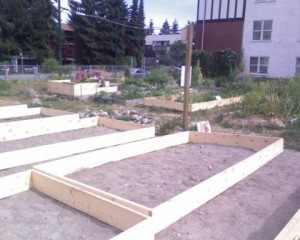
Garden Box Before
I must confess, I’ve been second guessing myself. Kind of like a bad break up, I’ve been asking the agonizing question: “Was it something I did? Or maybe something I didn’t do?” Did I leave in too many stones. We didn’t add a layer of topsoil. Do I have the “right” kind of soil or does it contain too much clay? Did we chose the right spot for the garden, is it getting enough sun?
Well, this time I’m starting the relationship off right.
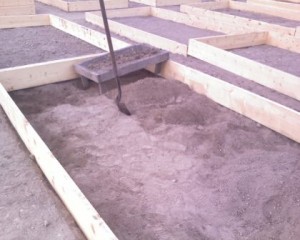
Sifting Soil
First on the agenda was leveling my planting box. The
spot I selected for my box is at a steep slop in one corner, which could lead to erosion and/or water pooling issues. So, I spent 3.5 hours one day this weekend digging in one side, raising the other, and shoring up the raised, downhill side to ensure my soil, when it arrives, will not wash away.
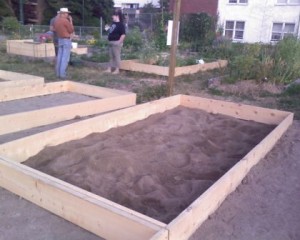
Garden Box After
Second, and included in the 3.5 hours of backbreaking, prison-camp-style hard labour, was a complete sift of the soil base to remove any rocks/debris. That meant digging up the top 6″ of soil within the box — deeper in some really rocky spots– and raking it over the “sieve” to remove any pieces bigger than about 1 cm.
One fine film of dust over me and all I own and 3 wheelbarrows of rocks later, my base soil is completely sifted and ready for a little peat moss alternative. After that’s done, I’ll just be awaiting the delivery of donated compost and then I can start planting. Boy, I hope that compost arrives soon!
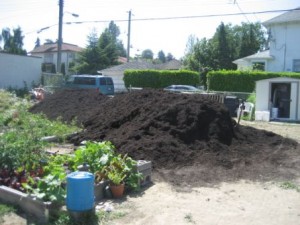 When the soil/compost arrived to fill the new boxes at my community garden, there was much rejoicing, and not just by me (okay, I might have been the loudest).
When the soil/compost arrived to fill the new boxes at my community garden, there was much rejoicing, and not just by me (okay, I might have been the loudest). 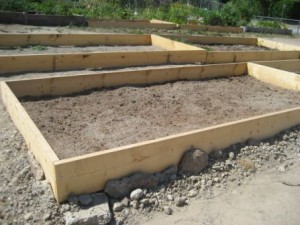
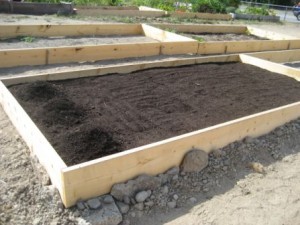

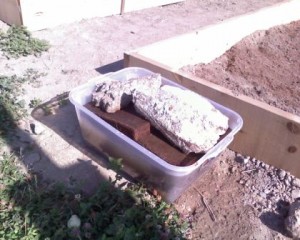 One of the fellows in the 16 Oaks Community Garden showed me what he’d done, mixing in a bunch of peat moss with the soil. His test showed that it did help keep the area damp and the area below the peat mixture was totally dry. On my next trip out to the nursery I was checking out the peat moss options when I noticed a peat alternative, made of coconut husks (coir). Cool! I’d read that
One of the fellows in the 16 Oaks Community Garden showed me what he’d done, mixing in a bunch of peat moss with the soil. His test showed that it did help keep the area damp and the area below the peat mixture was totally dry. On my next trip out to the nursery I was checking out the peat moss options when I noticed a peat alternative, made of coconut husks (coir). Cool! I’d read that 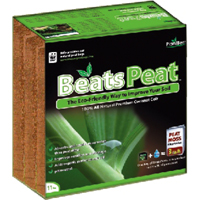 I picked up a couple of packages of Beats Peat, which are highly compressed bricks of the stuff which have to be soaked before being blended in with your soil. My first attempt consisted of dropping the bricks into my still-void-of-compost box and pouring copious amounts of water over them in order to soak them. It took a lot of lugging of water (see water source note, above) and, after a couple of hours, not much result.
I picked up a couple of packages of Beats Peat, which are highly compressed bricks of the stuff which have to be soaked before being blended in with your soil. My first attempt consisted of dropping the bricks into my still-void-of-compost box and pouring copious amounts of water over them in order to soak them. It took a lot of lugging of water (see water source note, above) and, after a couple of hours, not much result.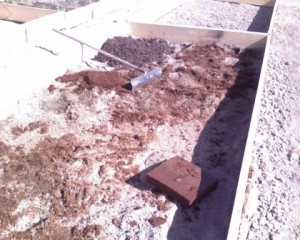 Right about the time I was finishing up the last of the 8 total bricks, a fellow garden I’ve seen around stopped by.
Right about the time I was finishing up the last of the 8 total bricks, a fellow garden I’ve seen around stopped by.


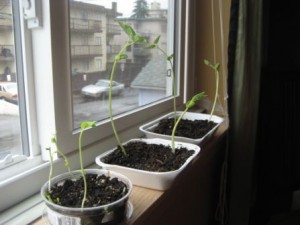 Despite the fact that I had very
Despite the fact that I had very